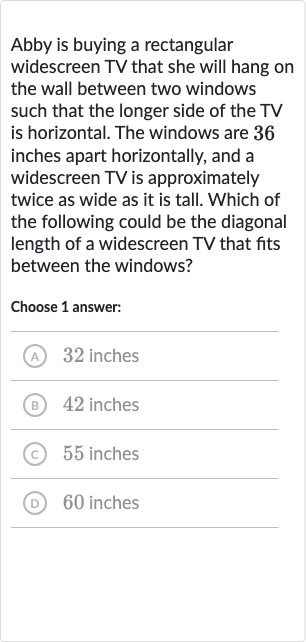AI tutor
Welcome to Bytelearn!
Let’s check out your problem:

Abby is buying a rectangular widescreen TV that she will hang on the wall between two windows such that the longer side of the TV is horizontal. The windows are inches apart horizontally, and a widescreen TV is approximately twice as wide as it is tall. Which of the following could be the diagonal length of a widescreen TV that fits between the windows?Choose answer:(A) inches(B) inches(C) inches(D) inches
Full solution
Q. Abby is buying a rectangular widescreen TV that she will hang on the wall between two windows such that the longer side of the TV is horizontal. The windows are inches apart horizontally, and a widescreen TV is approximately twice as wide as it is tall. Which of the following could be the diagonal length of a widescreen TV that fits between the windows?Choose answer:(A) inches(B) inches(C) inches(D) inches
- Understand Problem: Understand the problem and the given information.The space between the windows is inches, and the TV's aspect ratio is approximately , meaning the width is twice the height. We need to find a TV size that fits within this space, considering the diagonal length.
- Denote TV Dimensions: Let's denote the height of the TV as and the width as . According to the aspect ratio, . The diagonal can be found using the Pythagorean theorem, where .
- Substitute in Pythagorean Theorem: Substitute the width in terms of height into the Pythagorean theorem.
- Set Width Constraint: Since the width of the TV must be less than or equal to inches to fit between the windows, we set inches. Therefore, inches, which implies inches.
- Calculate Maximum Diagonal Length: Calculate the maximum possible diagonal length using the maximum height of inches.
- Compare with Options: Compare the calculated diagonal length with the given options.The calculated diagonal length is approximately inches, which is not an option. However, it is closest to option (B) inches, which is slightly larger than the calculated length. Since the TV must fit between the windows, the diagonal length must be less than or equal to the space available. Therefore, option (A) inches is the only possible size that is less than the calculated diagonal and also less than the space available between the windows.
More problems from Quantities that combine to zero: word problems
QuestionGet tutor help
QuestionGet tutor help
QuestionGet tutor help
QuestionGet tutor help
QuestionGet tutor help
QuestionGet tutor help
QuestionGet tutor help
QuestionGet tutor help
QuestionGet tutor help
